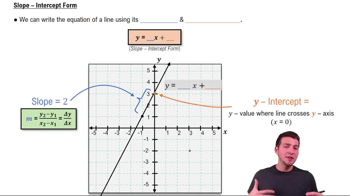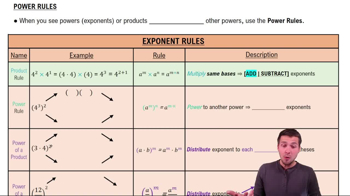Table of contents
- 0. Functions7h 52m
- Introduction to Functions16m
- Piecewise Functions10m
- Properties of Functions9m
- Common Functions1h 8m
- Transformations5m
- Combining Functions27m
- Exponent rules32m
- Exponential Functions28m
- Logarithmic Functions24m
- Properties of Logarithms34m
- Exponential & Logarithmic Equations35m
- Introduction to Trigonometric Functions38m
- Graphs of Trigonometric Functions44m
- Trigonometric Identities47m
- Inverse Trigonometric Functions48m
- 1. Limits and Continuity2h 2m
- 2. Intro to Derivatives1h 33m
- 3. Techniques of Differentiation3h 18m
- 4. Applications of Derivatives2h 38m
- 5. Graphical Applications of Derivatives6h 2m
- 6. Derivatives of Inverse, Exponential, & Logarithmic Functions2h 37m
- 7. Antiderivatives & Indefinite Integrals1h 26m
1. Limits and Continuity
Finding Limits Algebraically
Problem 23c
Textbook Question
Determine the following limits.
c. lim x→4 x − 5 / (x − 4)^2
 Verified step by step guidance
Verified step by step guidance1
Step 1: Identify the type of limit problem. This is a limit as x approaches a specific value, which may involve an indeterminate form. We need to evaluate \( \lim_{{x \to 4}} \frac{{x - 5}}{{(x - 4)^2}} \).
Step 2: Substitute x = 4 into the expression to check for indeterminate form. Substituting gives \( \frac{{4 - 5}}{{(4 - 4)^2}} = \frac{{-1}}{{0}} \), which is undefined, indicating a potential vertical asymptote or infinite limit.
Step 3: Analyze the behavior of the function as x approaches 4 from the left (x → 4⁻) and from the right (x → 4⁺). Consider the sign of the numerator and denominator in each case to determine the direction of the limit.
Step 4: For x approaching 4 from the left (x → 4⁻), the numerator (x - 5) is negative, and the denominator (x - 4)^2 is positive, leading to a negative result. For x approaching 4 from the right (x → 4⁺), the numerator is still negative, and the denominator remains positive, also leading to a negative result.
Step 5: Conclude that since both one-sided limits approach negative infinity, the overall limit \( \lim_{{x \to 4}} \frac{{x - 5}}{{(x - 4)^2}} \) is negative infinity.
Recommended similar problem, with video answer:
 Verified Solution
Verified SolutionThis video solution was recommended by our tutors as helpful for the problem above
Video duration:
2mPlay a video:
Was this helpful?
Key Concepts
Here are the essential concepts you must grasp in order to answer the question correctly.
Limits
A limit is a fundamental concept in calculus that describes the behavior of a function as its input approaches a certain value. It helps in understanding how functions behave near points of interest, including points where they may not be defined. In this case, we are interested in the limit as x approaches 4, which requires evaluating the function's behavior close to that point.
Recommended video:

One-Sided Limits
Indeterminate Forms
Indeterminate forms occur when direct substitution in a limit leads to an ambiguous result, such as 0/0 or ∞/∞. In the given limit, substituting x = 4 results in the form 0/0, indicating that further analysis is needed to determine the limit. Techniques such as factoring, rationalizing, or applying L'Hôpital's Rule can be used to resolve these forms.
Recommended video:
Guided course

Slope-Intercept Form
L'Hôpital's Rule
L'Hôpital's Rule is a method used to evaluate limits that result in indeterminate forms. It states that if the limit of f(x)/g(x) as x approaches a value results in 0/0 or ∞/∞, then the limit can be found by taking the derivative of the numerator and the derivative of the denominator. This rule simplifies the process of finding limits in cases where direct evaluation is not possible.
Recommended video:
Guided course

Power Rules

 5:21m
5:21mWatch next
Master Finding Limits by Direct Substitution with a bite sized video explanation from Callie
Start learningRelated Videos
Related Practice







